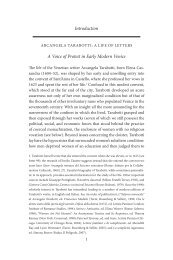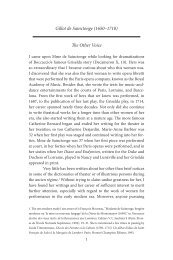Excerpt - Iter: Gateway to the Middle Ages and Renaissance
Excerpt - Iter: Gateway to the Middle Ages and Renaissance
Excerpt - Iter: Gateway to the Middle Ages and Renaissance
Create successful ePaper yourself
Turn your PDF publications into a flip-book with our unique Google optimized e-Paper software.
30 Edi<strong>to</strong>r’s Introduction<br />
<strong>the</strong> collection that convey alternately—or even simultaneously—<br />
sensuality <strong>and</strong> chastity, independence of spirit <strong>and</strong> adoration of<br />
<strong>the</strong> beloved’s intellectual powers, praise <strong>and</strong> criticism tempered<br />
with humor, desire for spiritual union <strong>and</strong> a need for distance or<br />
difference from <strong>the</strong> o<strong>the</strong>r.<br />
Dialogue, Imitation, <strong>and</strong> <strong>the</strong> Lyric Voice<br />
The poet’s transformation of a variety of literary conventions<br />
contributes <strong>to</strong> <strong>the</strong> complexity of voice in <strong>the</strong> Rymes, enriching ra<strong>the</strong>r<br />
than contradicting <strong>the</strong> all-encompassing, spiritual union in love<br />
that this poetry projects as an ideal. Saulnier’s “Etude” examines <strong>the</strong><br />
many traditions upon which Du Guillet builds her “art of variations”:<br />
medieval courtly love poetry, verse in <strong>the</strong> style of Marot <strong>and</strong> in <strong>the</strong><br />
Petrarchan mold, <strong>and</strong> poems inspired by Neopla<strong>to</strong>nism. To express<br />
an ideal of unity, <strong>the</strong> poet avails herself of multiple lyric traditions,<br />
creating a personal style that reinforces her independent identity <strong>and</strong><br />
voice. Despite her humble claims <strong>to</strong> <strong>the</strong> contrary, Du Guillet evidently<br />
possessed her share of <strong>the</strong> extensive knowledge that she attributed <strong>to</strong><br />
Scève. The multiple <strong>and</strong> at times contradic<strong>to</strong>ry voices in <strong>the</strong> Rymes<br />
represent a radical departure from <strong>the</strong> Délie. For Scève, as for Petrarch,<br />
<strong>the</strong> canzoniere depends upon <strong>the</strong> silence of <strong>the</strong> idealized woman. The<br />
lady’s unbroken silence <strong>and</strong> <strong>the</strong> <strong>to</strong>rment of <strong>the</strong> lover are <strong>the</strong> necessary<br />
conditions for poetic creation. 64<br />
At <strong>the</strong> heart of many of Du Guillet’s<br />
poems, however, is an exchange—of light, of knowledge, or of speech—<br />
with <strong>the</strong> beloved, with o<strong>the</strong>r contemporaries, with Amour (Cupid),<br />
with <strong>the</strong> reader, or with a combination of interlocu<strong>to</strong>rs. Fur<strong>the</strong>rmore,<br />
many of <strong>the</strong>se texts conclude with <strong>the</strong> speaker’s refusal <strong>to</strong> reduce her<br />
beloved poet <strong>to</strong> silence. Dialogue represents a central motif of <strong>the</strong><br />
collection, with numerous poems evoking a conversational exchange<br />
between lovers, or at least allowing <strong>the</strong> reader <strong>to</strong> “overhear” <strong>the</strong><br />
speaker’s words <strong>to</strong> ano<strong>the</strong>r. 65<br />
64. In both <strong>the</strong> Petrarchan <strong>and</strong> <strong>the</strong> Neopla<strong>to</strong>nic <strong>the</strong>ories of love, <strong>the</strong> woman remains <strong>the</strong><br />
silent object of <strong>the</strong> male gaze <strong>and</strong> desire; her silence fuels <strong>the</strong> speech of <strong>the</strong> lover, whose<br />
poetry expresses <strong>the</strong> stages <strong>and</strong> states of his suffering. In <strong>the</strong> Neopla<strong>to</strong>nic mode, this<br />
situation may permit <strong>the</strong> lover’s ascent <strong>to</strong> a higher spiritual realm, but in practice this applies<br />
only <strong>to</strong> men.<br />
65. For an examination of <strong>the</strong> types of linguistic exchanges depicted in <strong>the</strong> Rymes <strong>and</strong> <strong>the</strong><br />
lexical markers of dialogue, see Karen Simroth James, “On veult responce avoir: Pernette du<br />
Guillet’s Dialogic Poetics,” in A Dialogue of Voices: Feminist Theory <strong>and</strong> Bakhtin, ed. Karen<br />
Hohne <strong>and</strong> Helen Wussow (Minneapolis: University of Minnesota Press, 1994), 171–97,




